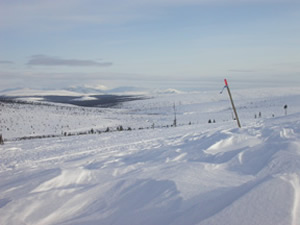A day in the life of Kenji Yoshikawa
A day in the life of Kenji Yoshikawa
Submitted by Ned Rozell
Phone: 907-474-7468
03/28/08



The University of Alaska Fairbanks’ Kenji Yoshikawa is making a snowmachine journey from Emmonak, at the mouth of the Yukon, to Kotzebue, about 800 trail miles away. Tohru Saito of the International Arctic Research Center and I are traveling with him. Here’s how Kenji’s day went today:
7 a.m.-He wakes on the floor of the Elim school library, under a sign that says "You will not get your way when you: holler, whine, yell, ignore, demand, or lay on the floor."
9 a.m.-Kenji tells the three junior-high-age students in a science class about permafrost, then takes them outside to look at a "frost tube," clear surgical tubing with blue water inside that fits inside a borehole and turns cloudy when it freezes. Students will use it to tell how deep the ground freezes.
9:30 a.m.-The wind is blowing from a cliff near the ocean as Kenji finishes his talk and the students rush back inside. Kenji slides a leg over his snowmachine seat and leads our three-machine caravan out of Elim, and out onto the sea ice and the Iditarod trail, still marked with wooden lathe painted orange at the top.
10:45 a.m.-We ride over "Little McKinley," a series of mostly treeless hills between Elim and Golovin.
11:30 a.m.-We arrive in Golovin; a small village on a spit extending into salt water about 29 miles from Elim.
11:35 a.m.-Kenji walks into the school and meets science teacher Jason Copenhaver.
11:40 a.m.-Kenji drills a hole behind the Golovin school to install a frost tube.
Noon-Kenji treats us to the school lunch, $6 for chicken nuggets, green peas, peach slices, bread and milk.
12:30 p.m.-Wearing black work pants, a tan shirt, an Underarmor cap, and his stocking feet, he speaks to his second class of the day in the second village of the day-eight children in Copenhaver’s class.
1 p.m.-He takes the class outdoors to look at the frost tube behind the school.
1:30 p.m.-Taking a tip from a local, Kenji decides to drill his deeper permafrost observatory on the south side of the Golovin peninsula. A chilly breeze snaps from the east, but it feels warm in the sunshine. He leans into the drill, putting his back into the work. The air smells clean except for the exhaust from the tiny Honda generator that’s powering the drill. The drill brings up sand intermixed with tiny ice crystals. "It’s beautiful permafrost," he says.
3:30-The drilling is done, and thermisters are installed in the hole. Tohru packs equipment and ratchets down straps over the gear on the snowmachine sled. We fire up our machines and head off the Golovin peninsula, back onto the sea ice and toward the village of White Mountain, 17 miles away.
4:20-We arrive in sunny White Mountain, a village built on a forested, south-facing slope.
4:30 p.m.-Kenji finds principal Andy Haviland, who tells us where to bunk and suggests that Kenji drill on the west end of town.
4:50 p.m.-Kenji and Tohru shovel three feet of snow from the ground and try to drill a permafrost observatory, but they hit bedrock before getting too deep. As Kenji and Tohru drill, Jack Adams and his wife Joanne drive by on snowmachines and invite us to a caribou stir-fry dinner.
6 p.m.-Kenji is on his phone to a colleague in Fairbanks who will fly to Nome tomorrow to help us gather supplies to continue our trip to Teller, Brevig Mission, Wales, Shishmaref, and beyond.
6:45 p.m.-"We should drill before we eat," Kenji tells Tohru.
8 p.m.-Kenji and Tohru finish drilling another frost tube site and make it to Jack and Joanne’s for dinner. Adrian, their son, shot the caribou in Death Valley, north of the White Mountains.
10 p.m.-We return to the school building where we’ll bunk for the night. Kenji downloads permafrost information from Golovin and Elim and checks his email. White Mountain has free wireless in the village core.
11 p.m.-I hear a blowtorch fire up at the other end of the room. Kenji is repairing equipment. I’m going to bed.
For more photos and trail reports, visit http://www.uaf.edu/permafrost and http://www.alaskatracks.com.
This column is provided as a public service by the Geophysical Institute, University of Alaska Fairbanks, in cooperation with the UAF research community. Ned Rozell is a science writer at the institute.


